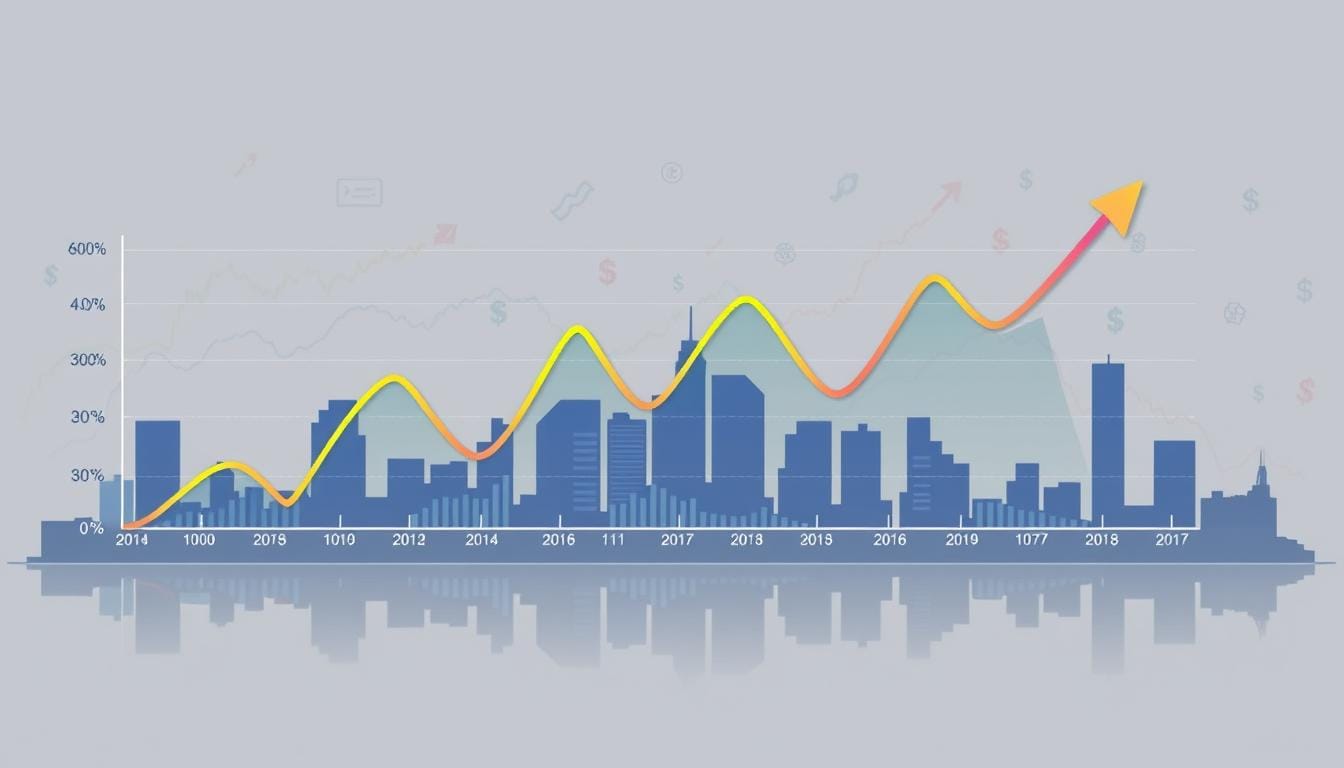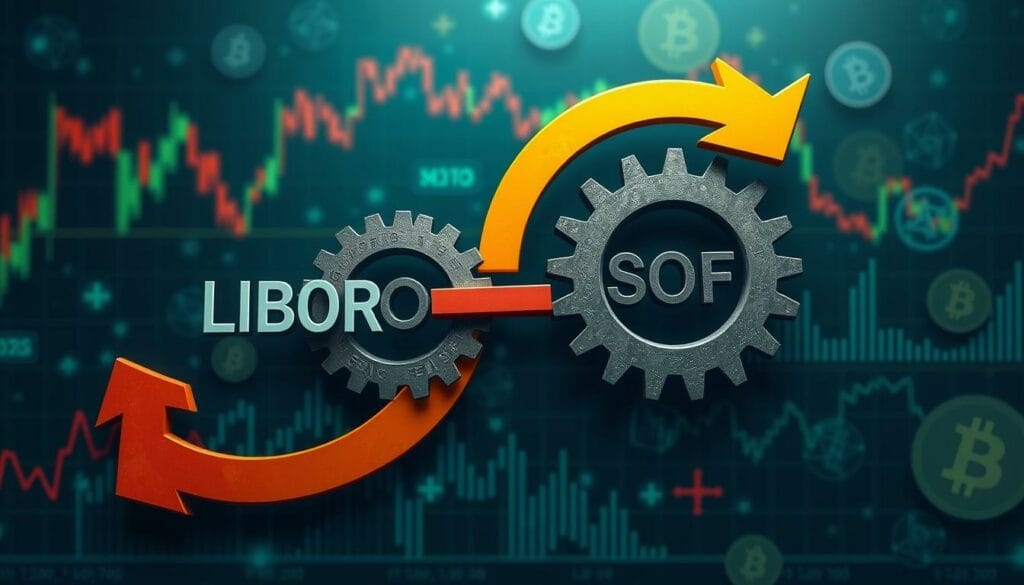SOFR Rates Explained: What You Need to Know

Table of Contents
The Secured Overnight Financing Rate (SOFR) is now the top interest rate for dollar-based derivatives and loans, replacing LIBOR1. It comes from the Treasury repo market, showing real market conditions and borrowing costs1. Unlike LIBOR, SOFR uses real transaction data, making it a stronger and clearer benchmark.
Switching from LIBOR to SOFR was a big job, done with help from regulators, banks, and market players2. It was finished by June 2023, making SOFR the main rate for many financial products like derivatives, loans, and credit for consumers2.
Key Takeaways
- SOFR is a benchmark interest rate based on actual transactions in the Treasury repo market, providing a more reliable and transparent alternative to LIBOR.
- SOFR has become the new standard for dollar-denominated derivatives and loans, replacing LIBOR by June 2023.
- SOFR is calculated by the New York Fed, with the rate published daily and average rates available for 30, 90, and 180-day periods.
- The transition to SOFR has faced some challenges, particularly in the derivatives market, but has been a coordinated effort involving regulators, financial institutions, and market participants.
- SOFR is viewed favorably by regulators for its robustness and availability, making it a suitable alternative to LIBOR for a wide range of financial products.
Introduction to SOFR
The Secured Overnight Financing Rate (SOFR) is a key interest rate that has become a top choice over the traditional U.S. dollar (USD) LIBOR3. It reflects the cost of borrowing overnight, secured by U.S. Treasury securities in the repo market. This market supports about $900 billion in daily transactions, making SOFR a solid and trustworthy benchmark3. In contrast, USD LIBOR is backed by less than $1 billion in daily transactions, making SOFR more reliable3.
What is the Secured Overnight Financing Rate (SOFR)?
SOFR is a benchmark interest rate chosen by the Alternative Reference Rates Committee (ARRC) in 2017 as a better option than USD LIBOR4. The move away from LIBOR came due to concerns over its unreliability and potential for manipulation, as well as a drop in interbank lending that supported the rate4. The New York Federal Reserve calculates SOFR, using actual borrowing costs from the Treasury repo market. This makes SOFR more transparent than LIBOR4.
History and Purpose of SOFR
The creation of SOFR was prompted by the LIBOR scandal in 2012, which showed how global banks manipulated LIBOR4. UK regulators then set a 2021 deadline for financial firms and investors to switch to alternative rates4. The LIBOR Act of 2022 made SOFR the official replacement for LIBOR in contracts without a plan for LIBOR’s end4. SOFR aims to be a more transparent and dependable benchmark, aiming to replace the troubled LIBOR345.
| Characteristic | SOFR | LIBOR |
|---|---|---|
| Underlying Market | Actual transactions in the Treasury repurchase (repo) market | Panel bank submissions for hypothetical interbank lending rates |
| Transparency | High, based on real transaction data | Low, due to panel bank submissions |
| Manipulation Risks | Low, as it is based on a large, liquid market | High, as demonstrated by the LIBOR scandal |
| Liquidity | Approximately $900 billion in daily transactions | Less than $1 billion in daily transactions |
SOFR was created as an alternative to LIBOR, seen as vulnerable to manipulation4. The LIBOR Act of 2022 confirmed SOFR as the main replacement for LIBOR contracts, highlighting its key role in the shift from LIBOR to new benchmarks4.
“SOFR solves the rigging problem but may need to coexist with other rates.”
– Bank for International Settlements
SOFR as an Alternative to LIBOR
The Secured Overnight Financing Rate (SOFR) is now the top choice over the old London Interbank Offered Rate (LIBOR). This is because SOFR has a strong market base and clear borrowing costs6. It’s based on real overnight deals in the U.S. Treasury repo market, with over $1 trillion traded daily. This makes it more trustworthy and less open to manipulation than LIBOR7.
Switching from LIBOR to SOFR is a big job, with trillions of dollars’ worth of contracts needing to change by June 30, 20236. The U.S. Federal Reserve set up the Alternative Reference Rate Committee (ARRC) to find a new rate. They picked SOFR in 2017 as the best alternative7. This change was to fix the fraud and manipulation problems with LIBOR, offering clearer borrowing costs6.
There were challenges in moving from LIBOR to SOFR. For example, figuring out a fair way to switch rates and needing “fallback clauses” in old loans tied to LIBOR6. Also, setting new loan prices under SOFR meant adjusting credit spreads to match the differences between LIBOR and SOFR base rates6.
Even though SOFR is the main U.S. dollar interest rate benchmark, other rates like Ameribor and Bloomberg Short-Term Bank Yield (BSBY) serve specific markets6. In the end, using SOFR marks a big move towards a more open and dependable system of interest rates6.
| Benchmark Interest Rate | Key Characteristics |
|---|---|
| LIBOR (London Interbank Offered Rate) |
|
| SOFR (Secured Overnight Financing Rate) |
|
The move from LIBOR to SOFR is a key step in improving benchmark interest rates. It aims to build a stronger and clearer financial system678.

How SOFR Works
The Secured Overnight Financing Rate (SOFR) is a key interest rate widely used in finance9. It changes daily, based on the previous day’s repo market activity9. This makes it a crucial benchmark for financial markets9.
Underlying Market for SOFR
SOFR comes from the Treasury repurchase (repo) market. Here, a variety of financial institutions lend and borrow cash using U.S. Treasury securities as collateral10. It’s now the main interest-rate benchmark in the U.S. dollar, replacing LIBOR10.
Calculation Methodology of SOFR
The New York Fed uses a special method to calculate SOFR. It looks at the volume-weighted median of repo market transactions10. This ensures a fair and accurate view of overnight borrowing costs10.
SOFR is tied to the overnight cost of borrowing through U.S. Treasuries repurchase agreements10. The Federal Reserve Bank of New York publishes it daily at or near 8 a.m. Eastern time10.
| SOFR Rates | Description |
|---|---|
| Daily SOFR Rate | SOFR is a daily updated rate calculated and published daily9. |
| SOFR Averages | In addition to the daily SOFR rate, 30-, 90-, and 180-day SOFR averages are published to smooth volatility11. |
Since January 2022, SOFR has replaced LIBOR for new loans in the U.S9.. It’s used by financial institutions to measure overnight borrowing costs9. SOFR shows if mortgage rates are going up or down9.

“SOFR is considered more reliable due to more than $1 trillion in daily transaction volumes underlying this rate, making it less prone to manipulation compared to LIBOR.”10
Characteristics of SOFR
The Secured Overnight Financing Rate (SOFR) is a strong and trustworthy benchmark interest rate. It’s seen as a better choice than the London Interbank Offered Rate (LIBOR), which faced scandals12. SOFR’s strength comes from its large and varied market, with daily transactions near $1 trillion in 2020. This makes it the biggest rates market in the U.S12..
SOFR is calculated by averaging transaction data from a business day. This method makes it reliable and clear12. Also, SOFR is shared on the Federal Reserve Bank of New York’s website around 8:00 a.m. ET the next day. This gives market players timely and checked data12.
Transition from LIBOR to SOFR
Switching from LIBOR to SOFR is a big change for the financial world13. Since 2019, trillions of dollars in floating-rate notes linked to SOFR have been issued in the U.S13.. The Treasury repo market, SOFR’s base, sees over $1 trillion in daily deals. This shows the market’s size and liquidity13.
The move away from LIBOR, a key loan benchmark since the 1980s, is due to LIBOR’s manipulation issues13. The Federal Reserve backs SOFR as the new benchmark, expecting it to replace LIBOR by 202114.

SOFR has shown it’s reliable and strong. But, the market will keep growing as more people use it14. Issues like index volatility and credit spread changes will need to be tackled. Alternative rates like AMERIBOR could also play a part, showing costs of unsecured overnight loans14.
sofr rates
The Secured Overnight Financing Rate (SOFR) is now a key interest rate, replacing LIBOR. It’s used for many financial tools15. As of June 1, 2023, the SOFR rate was 5.08%, reported by the Federal Reserve Bank of New York2.
SOFR Averages give a clear view of SOFR rates over different time frames. By April 25, 2024, the rates were 5.33002% for the last 30 days, 5.34776% for 90 days, and 5.39029% for 180 days16.
| Metric | Value |
|---|---|
| Latest SOFR Rate (September 5, 2024) | 5.35% |
| Repo Transactions Used for SOFR Calculation | $2.2 Trillion (98% between 5.30% and 5.46%) |
| LIBOR Fallback Rate (September 5, 2024) | 5.35644% |
| SOFR Averages (September 6, 2024) | 1-month: 5.34274%, 3-month: 5.36805%, 6-month: 5.39590% |
| SOFR Index (September 6, 2024) | 1.15691889 |
SOFR is a strong and trustworthy benchmark. Its averages over the past 30 days have been between 5.32% and 5.35%. LIBOR fallback rates have been from 5.32644% to 5.35644%16.

The move from LIBOR to SOFR is a big step forward. It started with Fannie Mae’s first SOFR security in July 2018. Now, SOFR is becoming a key part of global finance16. As markets adjust, SOFR rates will be vital for secured overnight financing21516.
Transition from LIBOR to SOFR
The shift from the London Interbank Offered Rate (LIBOR) to the Secured Overnight Financing Rate (SOFR) marked a big change in finance17. SOFR is now seen as a top choice over USD LIBOR. The Federal Reserve Bank of New York started publishing SOFR in April 201818.
Timeline and Milestones
In 2017, the Alternative Reference Rates Committee (ARRC) picked SOFR as a new benchmark instead of USD LIBOR18. On November 30, 2020, the Federal Reserve said LIBOR would fade out. Banks were told to stop using LIBOR by the end of 202118. By June 30, 2023, all LIBOR rates stopped, and SOFR took over as the benchmark for dollar contracts17.
This change was a worldwide effort. Countries like the UK, EU, Japan, Switzerland, and Canada moved to new rates like SONIA, ESTR, TONAR, SARON, and CORRA17.

The switch from LIBOR came from a need for stronger and more dependable benchmark interest rates18. LIBOR was in about $200 trillion of financial deals and securities17. The ICE Benchmark Administration (IBA) stopped publishing non-USD LIBOR rates and some USD LIBOR tenors in December 202117. After June 2023, banks didn’t have to give info for USD LIBOR rates anymore17.
“The transition from LIBOR to SOFR is a significant event in the financial markets, as it marks the shift to a more robust and reliable benchmark interest rate.”
SOFR, with daily volumes of about $1 trillion, is a clear and data-focused alternative to LIBOR17. The switch to SOFR aims to make the financial system more stable and trustworthy1718.
Impact of SOFR Transition
The switch from the London Interbank Offered Rate (LIBOR) to the Secured Overnight Financing Rate (SOFR) is changing financial markets and products19. On June 30, 2023, US dollar Libor rates for one-, three-, six-, and 12-month terms stopped being published, marking a big change19. This change mainly affects the derivatives market and products like adjustable-rate mortgages and private student loans19. It also changes debt instruments such as commercial paper.
Companies working across borders and in different places need to understand interest rates like SONIA in the UK and EONIA in Europe for a smooth transition19. SOFR futures and swaps help manage interest rate risks based on SOFR19. New products like SOFR-linked floating rate notes (FRNs) and SOFR-indexed loans are being introduced as alternatives to old Libor-based products19.
SOFR is becoming more common in mortgages and deposits offered by banks19. Also, SOFR-linked swaptions and structured products like certificates of deposit and notes are being designed with SOFR as the reference rate19.
The move to SOFR is affecting the market for interest rate benchmarks20. Over $1 trillion in daily transactions rely on SOFR, according to the U.S. Department of the Treasury20. Most financial institutions have met the requirements to switch to new rates like SOFR20. But, swaptions are still developing, while swaps have strong liquidity20.
Switching from LIBOR to SOFR comes with challenges21. USD LIBOR is tied to about USD200tn of financial contracts and securities, with USD8.3tn related to securitisations21. When LIBOR stops in mid-2023, many will be affected, including corporate borrowers, end users of derivatives, investment banks, investors, consumers with loans tied to LIBOR, and credit card users21. Improving analytic libraries and operational capabilities is key to overcoming these challenges19.

SOFR and Financial Products
Derivatives and Cash Products
The Secured Overnight Financing Rate (SOFR) is now a key benchmark for many financial products. It’s used in interest rate swaps, where one side pays a fixed rate and the other pays a floating rate tied to SOFR1.
SOFR is also popular in cash products like adjustable-rate mortgages and commercial paper. It’s involved in about $1 trillion in daily transactions, much more than other U.S. money market volumes1.
About 2,000 institutions use the Treasury repo market, which is a big part of SOFR’s daily activity, around $1 trillion in 20201. Money market funds, with $4.5 trillion in assets, also touch the repo market, key for SOFR1.
| Benchmark | Daily Average Volume | Spread to SOFR | Annualized Return Difference |
|---|---|---|---|
| SOFR | $977 billion | – | – |
| USD LIBOR | A few hundred million | 0.29% | 0.30% lower than SOFR |
SOFR’s strong governance and methods mirror international standards, making it a trustworthy overnight Treasury repo market benchmark1. The New York Fed has been publishing SOFR rates and averages since March 20201.
As the financial world moves from LIBOR to SOFR, it’s important to quickly adopt SOFR in financial contracts1. This shift is urgent since LIBOR might end after 2021. Over 300 institutions and groups are working together to help with this change1.
“SOFR has become a widely accepted alternative to LIBOR, with its robust governance and large underlying transaction volume making it a reliable benchmark for a broad range of financial products.”
SOFR Adoption by Market Participants
The Secured Overnight Financing Rate (SOFR) is becoming a key interest rate, thanks to the Alternative Reference Rates Committee (ARRC)22. The ARRC, formed in 2018, has led the move away from the USD London Interbank Offered Rate (LIBOR)22. In 2020, it shared clear steps for the market to follow22.
The ARRC includes banks, regulators, and private companies, making the switch to SOFR easier22. This teamwork has helped make the change global, with similar groups in other currencies22.
Many financial groups, like asset managers and banks, now use SOFR22. This move has made SOFR a top choice after USD LIBOR22.
| Metric | Improvement |
|---|---|
| SOFR median bid/offer spreads | Improved over the year23. |
| Tightening of bid/offer spreads | More noticeable in longer-term SOFR swaps after July 26, 202123. |
| SOFR bid/offer spreads | Were wider than LIBOR but getting closer23. |
| SOFR rate variance | Has decreased, now similar to LIBOR23. |
| SOFR price refresh rates | Improved but still not as fast as LIBOR23. |
| SOFR swap yield change | Has been falling, showing better liquidity and market understanding23. |
| SOFR swap quote size | Increased, showing more dealer comfort with large trades and market liquidity23. |
For the latest on Risk-Free Rates (RFRs), including SOFR, check Tradeweb’s RFR Resource Center23.
About 96 percent of new loans used SOFR by April 202224. The spread adjustments for old LIBOR loans vary, while new SOFR loans in 2022 have different spreads24.
Financial markets need to switch from LIBOR to SOFR by next June to avoid issues24. The Loan Syndications and Trading Association (LSTA) has a model agreement for Term SOFR widely used, and most LIBOR loans have fallback options for switching24.
The US loan market’s support for Term SOFR has helped make the switch successful24.
“Many market players, including asset managers and banks, have chosen SOFR, making it a strong and reliable interest rate.”
Challenges and Considerations
Switching from LIBOR to SOFR brings challenges for companies doing business across borders. Each region has its own alternative reference rate. For instance, SOFR is now the go-to for dollar contracts in the U.S. But, market players need to know the different rates used in other places to smoothly switch and keep their financial deals consistent25.
Cross-border Transactions and Benchmark Alignment
Today’s finance world is global, making it hard to keep up with different benchmark interest rates. The UK uses SONIA instead of LIBOR, and Europe has chosen EONIA. It’s key for companies working across borders to match these rates to keep everything in line25.
To tackle this, companies need to deeply understand each benchmark’s details. This includes its market dynamics, how it’s calculated, and the rules around it. Knowing this will help them adjust their financial deals and follow the law in each country25.
| Benchmark Interest Rate | Region | Key Characteristics |
|---|---|---|
| SOFR | United States | Secured overnight financing rate, based on the highly liquid U.S. Treasury repurchase (repo) market, which had an average daily volume of $900 billion in March 202126. |
| SONIA | United Kingdom | Sterling Overnight Index Average, based on unsecured overnight lending transactions in the British sterling market. |
| EONIA | Europe | Euro Overnight Index Average, based on overnight lending transactions in the euro-denominated market. |
By matching these rates and keeping a consistent approach, companies can lessen the risks linked to the LIBOR change25.
“The move from LIBOR to SOFR is a complex process that needs careful planning and knowledge of the global benchmark rates. Companies must make sure they’re in sync with these rates to keep their financial deals solid.”
– Renee Kuhl, Managing Director for the Loan Agency Group at SRS Acquiom25
SOFR Averages and Term Rates
The New York Fed publishes SOFR Averages for 30-day, 90-day, and 180-day periods, along with a SOFR Index27. These averages help market players build SOFR-linked contracts27.
Term SOFR Reference Rates from the CME Group are also available for one-month, three-month, and six-month periods27. The CME is adding a 12-month rate soon27. The ARRC picked the CME to manage a forward-looking SOFR term rate when market conditions are right27.
Using SOFR in financial contracts is becoming more common, thanks to its use in futures, swaps, and floating-rate debt27. SOFR Averages and CME’s Term SOFR Rates are available for different time periods27. Both use Actual/360 days for calculations, a common method in US money markets27.
If a benchmark rate is unavailable, interpolation can be used, depending on the situation27. For periods not matching one, three, or six months, the next closest rate or interpolation is used27.
“A resource titled ‘The Different SOFR Rates’ was put together last year to explain the various SOFR rates.”28
The shift from LIBOR to SOFR is ongoing, offering more benchmark interest rates for new financial contracts.
Regulatory Landscape and SOFR
Financial regulators have pushed for a switch from LIBOR to SOFR. They’re concerned about LIBOR’s risk of being manipulated and its link to less lending between banks29. The group that oversees LIBOR says it won’t provide the rate after 2021. They’re pushing for SOFR as the new standard for dollar deals30.
The rules around switching from LIBOR to SOFR are changing fast31. A group called the Alternative Reference Rates Committee (ARRC) is leading the way to SOFR. They’ve made a plan to help markets switch to SOFR smoothly, covering things like derivatives and floating-rate notes31.
Groups like the Federal Reserve and the UK Financial Conduct Authority are giving guidance and setting deadlines for leaving LIBOR behind31. For instance, a law passed in March 2022 helped ease the move for $75 trillion in “tough legacy” loans30.
As the finance world changes, everyone needs to adjust to new ways of pricing and dealing with SOFR29. The rules around SOFR are still changing, aiming for a smooth shift away from LIBOR31.
Future Outlook for SOFR
The shift from LIBOR to SOFR is moving forward, and the outlook for this interest rate is bright. The Alternative Reference Rates Committee (ARRC) urges quick adoption of SOFR in financial contracts. They suggest using SOFR fallback language in new LIBOR contracts32. While some contracts might use a forward-looking SOFR term, most should switch to SOFR directly. This helps in creating a strong SOFR derivatives market, which is key for a smooth transition33.
The ARRC is dedicated to fostering a dynamic market with reliable reference rates. These rates follow international standards and are ready for use before LIBOR’s end33. In 2024, SOFR stayed steady at 5.31 percent, and daily repo transactions hit over $1.5 trillion33. The Fed’s Overnight Reverse Repo (ON RRP) facility has set a low rate since 201333. The Standing Repo Facility (SRF) has a higher rate at the top of the target range33. By May 2024, only 36 participants were in SRF deals, and most repo rates were below the SRF since 202133.
Reductions in the Fed’s balance sheet have made less funds available for SOFR, pushing its rate up slightly within the target range33. But, the Fed has slowed down its tightening, which might halt the SOFR increase soon33. Overall, the outlook for SOFR is strong, thanks to the ARRC’s support for a robust market.
“The ARRC remains committed to supporting a vibrant and innovative market with reference rates that are robust, consistent with international best practices, and available for use before the end of the LIBOR transition period.”
Conclusion
The move from LIBOR to SOFR has changed the financial world. SOFR is now the top choice for dollar-based derivatives and loans. It’s based on a wide, diverse market and follows international standards, making it a better choice than LIBOR34.
Many big names in finance and government agencies have started using SOFR. This has helped make it the new standard for U.S. dollar financial products34. As the switch continues, there are challenges like handling cross-border deals and new reference rates. But, SOFR’s clear and strong nature offers big advantages.
The shift from LIBOR to SOFR has had its ups and downs. Yet, the finance world’s effort to switch shows how crucial a stable and clear benchmark is for the global economy. With SOFR becoming more popular, it’s set to be key in a safer, more efficient financial world. This marks the start of a new era for benchmark interest rates35.
FAQ
What is the Secured Overnight Financing Rate (SOFR)?
SOFR is a key interest rate that shows the cost of borrowing overnight. It uses U.S. Treasury securities as collateral in the repo market. It’s seen as a better choice than the old USD LIBOR for credit agreements.
Why was SOFR chosen as the alternative to LIBOR?
SOFR was picked because it has a strong market with over
FAQ
What is the Secured Overnight Financing Rate (SOFR)?
SOFR is a key interest rate that shows the cost of borrowing overnight. It uses U.S. Treasury securities as collateral in the repo market. It’s seen as a better choice than the old USD LIBOR for credit agreements.
Why was SOFR chosen as the alternative to LIBOR?
SOFR was picked because it has a strong market with over $1 trillion in daily deals. It’s based on real transactions, not just guesses. Unlike LIBOR, which could be changed by banks, SOFR reflects real borrowing costs.
How is SOFR calculated?
SOFR comes from the Treasury repo market, where many types of lenders and borrowers trade cash using U.S. Treasury securities. The New York Fed uses the volume-weighted median of these deals to calculate SOFR. This makes it a solid measure of overnight borrowing costs.
What are the key characteristics of SOFR?
SOFR is seen as trustworthy because it’s based on a big, diverse market with over $1 trillion in daily deals. It follows international standards and is less likely to be manipulated than LIBOR.
What was the timeline for the transition from LIBOR to SOFR?
The switch from LIBOR to SOFR was a big change in finance. In 2017, SOFR was chosen as the top alternative to USD LIBOR. The New York Fed started publishing SOFR in April 2018.
On November 30, 2020, the Federal Reserve said LIBOR would be phased out. Banks were told to stop using LIBOR by the end of 2021. By June 30, 2023, LIBOR was fully replaced by SOFR for dollar contracts.
How is SOFR being used in financial products?
SOFR is now used in many financial products, like derivatives and cash products that used to reference USD LIBOR. In derivatives, it’s used in interest rate swaps. In cash products, it’s used in adjustable-rate mortgages and commercial paper.
What are some of the challenges associated with the transition from LIBOR to SOFR?
Switching to SOFR is hard, especially for those doing business across borders. While SOFR is the benchmark in the U.S., other countries have their own rates, like SONIA in the UK and EONIA in Europe. Understanding these rates is key to a smooth transition.
What are the SOFR Averages and how are they used?
The New York Fed also publishes SOFR Averages for different time periods, like 30-day and 180-day averages. These, along with a SOFR Index, help market players build SOFR-linked contracts.
What is the regulatory landscape surrounding SOFR?
Financial regulators have told market players to stop counting on LIBOR after 2021. They’re pushing for SOFR as the new standard for dollar contracts. The ARRC urges using SOFR in contracts and adding SOFR fallbacks if new LIBOR contracts are made.
trillion in daily deals. It’s based on real transactions, not just guesses. Unlike LIBOR, which could be changed by banks, SOFR reflects real borrowing costs.
How is SOFR calculated?
SOFR comes from the Treasury repo market, where many types of lenders and borrowers trade cash using U.S. Treasury securities. The New York Fed uses the volume-weighted median of these deals to calculate SOFR. This makes it a solid measure of overnight borrowing costs.
What are the key characteristics of SOFR?
SOFR is seen as trustworthy because it’s based on a big, diverse market with over
FAQ
What is the Secured Overnight Financing Rate (SOFR)?
SOFR is a key interest rate that shows the cost of borrowing overnight. It uses U.S. Treasury securities as collateral in the repo market. It’s seen as a better choice than the old USD LIBOR for credit agreements.
Why was SOFR chosen as the alternative to LIBOR?
SOFR was picked because it has a strong market with over $1 trillion in daily deals. It’s based on real transactions, not just guesses. Unlike LIBOR, which could be changed by banks, SOFR reflects real borrowing costs.
How is SOFR calculated?
SOFR comes from the Treasury repo market, where many types of lenders and borrowers trade cash using U.S. Treasury securities. The New York Fed uses the volume-weighted median of these deals to calculate SOFR. This makes it a solid measure of overnight borrowing costs.
What are the key characteristics of SOFR?
SOFR is seen as trustworthy because it’s based on a big, diverse market with over $1 trillion in daily deals. It follows international standards and is less likely to be manipulated than LIBOR.
What was the timeline for the transition from LIBOR to SOFR?
The switch from LIBOR to SOFR was a big change in finance. In 2017, SOFR was chosen as the top alternative to USD LIBOR. The New York Fed started publishing SOFR in April 2018.
On November 30, 2020, the Federal Reserve said LIBOR would be phased out. Banks were told to stop using LIBOR by the end of 2021. By June 30, 2023, LIBOR was fully replaced by SOFR for dollar contracts.
How is SOFR being used in financial products?
SOFR is now used in many financial products, like derivatives and cash products that used to reference USD LIBOR. In derivatives, it’s used in interest rate swaps. In cash products, it’s used in adjustable-rate mortgages and commercial paper.
What are some of the challenges associated with the transition from LIBOR to SOFR?
Switching to SOFR is hard, especially for those doing business across borders. While SOFR is the benchmark in the U.S., other countries have their own rates, like SONIA in the UK and EONIA in Europe. Understanding these rates is key to a smooth transition.
What are the SOFR Averages and how are they used?
The New York Fed also publishes SOFR Averages for different time periods, like 30-day and 180-day averages. These, along with a SOFR Index, help market players build SOFR-linked contracts.
What is the regulatory landscape surrounding SOFR?
Financial regulators have told market players to stop counting on LIBOR after 2021. They’re pushing for SOFR as the new standard for dollar contracts. The ARRC urges using SOFR in contracts and adding SOFR fallbacks if new LIBOR contracts are made.
trillion in daily deals. It follows international standards and is less likely to be manipulated than LIBOR.
What was the timeline for the transition from LIBOR to SOFR?
The switch from LIBOR to SOFR was a big change in finance. In 2017, SOFR was chosen as the top alternative to USD LIBOR. The New York Fed started publishing SOFR in April 2018.
On November 30, 2020, the Federal Reserve said LIBOR would be phased out. Banks were told to stop using LIBOR by the end of 2021. By June 30, 2023, LIBOR was fully replaced by SOFR for dollar contracts.
How is SOFR being used in financial products?
SOFR is now used in many financial products, like derivatives and cash products that used to reference USD LIBOR. In derivatives, it’s used in interest rate swaps. In cash products, it’s used in adjustable-rate mortgages and commercial paper.
What are some of the challenges associated with the transition from LIBOR to SOFR?
Switching to SOFR is hard, especially for those doing business across borders. While SOFR is the benchmark in the U.S., other countries have their own rates, like SONIA in the UK and EONIA in Europe. Understanding these rates is key to a smooth transition.
What are the SOFR Averages and how are they used?
The New York Fed also publishes SOFR Averages for different time periods, like 30-day and 180-day averages. These, along with a SOFR Index, help market players build SOFR-linked contracts.
What is the regulatory landscape surrounding SOFR?
Financial regulators have told market players to stop counting on LIBOR after 2021. They’re pushing for SOFR as the new standard for dollar contracts. The ARRC urges using SOFR in contracts and adding SOFR fallbacks if new LIBOR contracts are made.
Source Links
- Secured Overnight Financing Rate (SOFR) Definition and History
- SOFR: A Comprehensive Guide
- SOFR
- SOFR: The Secured Overnight Financing Rate
- Differences Between LIBOR and SOFR
- – Alternative Reference Rates Committee
- LIBOR to SOFR Transition: What You Need to Know
- What is SOFR (Secured Overnight Financing Rate)? | Chase
- Secured Overnight Financing Rate (SOFR), Defined And Explained
- What Is SOFR And How Does It Work? | Quicken Loans
- Secured Overnight Financing Rate (SOFR)
- SOFR: Key Characteristics & Hedge Accounting Impacts
- 10-Year Swap Rates, Treasuries, Fallback Rate (SOFR), SOFR, Term SOFR
- Secured Overnight Financing Rate (SOFR) Updates
- LIBOR to SOFR Transition
- PowerPoint Presentation
- Beyond Libor: the impact of SOFR on rates, bonds and loans – Risk.net
- Exploring 3 Major Challenges of the SOFR Transition
- The fall of LIBOR and the rise of SOFR
- Measuring the Market Transition from LIBOR
- SOFR transition progresses despite volatile markets | White & Case LLP
- SOFR Today: Credit-Spread Adjustments (CSA)
- Considerations for a Transition to SOFR and other Alternative Rates – SECOR Asset Management
- Term SOFR vs Daily Simple SOFR – What’s the Difference?
- Lenders, LIBOR, and the move to the risk-free SOFR rate: seven takeaways for financial services firms
- SOFR Today | Credit Spend Adjustments | Rising Interest Rate
- LIBOR is Dead. Long Live SOFR – The Global Treasurer
- Life After LIBOR: A Comprehensive Financial Outlook
- SOFR, so good? The outlook for the ‘world’s most important number’
- What is SOFR, and Why is it Replacing LIBOR? – Penserra
- What is SOFR? Secured Overnight Financing Rate | Rate






